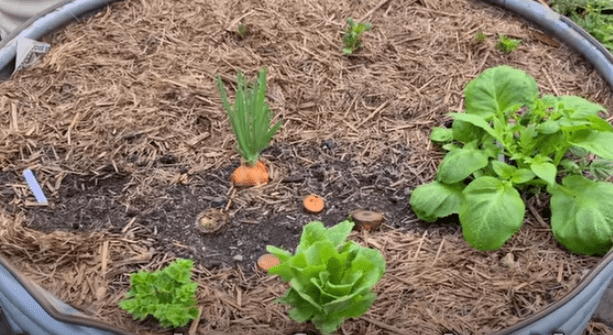Your gardening journey can start with just a few scraps that you would typically toss away, some jars, and a few unused pots.
There are three important rules to growing your own produce from kitchen scraps:
- Change the water every day, if this is neglected the fruit or vegetable will start to smell and become slimy.
- Keep the scraps on a west-facing windowsill to receive indirect sunlight.
- Once they have grown enough to be planted outdoors, water the roots consistently but make sure the ground is still firm.
Some of your favourite foods can be easily regrown from the comfort of your home.
Bulb Vegetables:
Celery, Lettuce, Cabbage, Bok Choy
Bulb vegetables are some of the easiest to regrow, all you need to do is cut the base off your vegetable leaving around two inches. Place the scraps cut-side down into a bowl that holds enough water to cover the base, and change this water daily.
Within three to four days you should start to see sprouting, but make sure that the plants have sunlight to help with growth. Once roots start to form, you can move them to be planted in the garden. Ensure the new stems are above the ground whilst the base and roots are covered entirely.
Root Vegetables:
Carrots, Radishes, Beetroots, Turnips, Spring Onion, Onions
Root vegetables can easily be regrown either using water or soil. When cutting your scrap pieces, the top portion where the root is will regrow if you place them cut-side-down into a bowl of shallow water.
These can be kept inside the home, and within a few weeks, you will begin to see new greens sprouting. Once you can see side roots, plant them outdoors completely covering both the root and base in soil. The best thing about root vegetables is that they can be harvested and continually regrown.
Seeded Vegetables:
Tomatoes, Peppers, Squash, Chillies, Bean Sprouts, Pumpkin and Cucumbers
Cut thin slices of your seeded vegetables and sit them on the side to dry out, this makes the seeds easier to get hold of and use, then harvest the seeds and place them in a container with soil.
Place the pot in a warm location making sure to water daily and wait for the seeds to start sprouting. Once the sprouts have broken through the soil, repot the plants in your garden.
Another alternative is to remove the seeds and sprinkle them across a bed of soil, water daily and watch the magic happen.
Fruits:
Lemons, Oranges, Apples, Cherries, Peaches, Plums and Avocados
Many of the fruits we enjoy have seeds that can be reused. Instead of chucking them out, save them and plant them in fertile potting soil. Although fruit trees can take years to form and grow, once they have you will consistently have fresh fruit to enjoy.
Strawberries
Cut the outer skin of the berry or extract the seeds using a pair of tweezers. Place the skin or seed into a soiled container, make sure the soil covers it all and place them in a sunny, warm spot. Water consistently until you begin spotting sprouts, then transplant these to a strawberry pot in the garden to continue growth.
Pineapple
Luckily, you don’t have to be in a tropical country to grow this mouth-watering fruit. It takes 2-3 years to see the first crop but the results make it worth it! Cut the top off of a pineapple and dry this out as they tend to rot quickly. Plant the top into soil with the leaves sticking out, and leave it in a bright location for warmth and light. It will need at least eight hours of sunlight a day and of course, make sure it is watered when the soil dries. Within three to four months you will see roots sprouting.
Ingredients:
Organic Potatoes
Potatoes are susceptible to disease so always buy organic, untreated potatoes for the best regrowth results. Place multiple potatoes into a brown paper bag and leave in a dark location. Check every few days for sprouting, and once each has three to four shoots, remove them from the bag.
Cut into halves, ensuring both have sprouts, and leave to dry for two days. Once dried, place each half in eight inches of fertile soil.
Horticulturist and Gardening expert Zach Morgan from Fantastic Services’ commented on the benefits of replanting our food scraps.
“Planting leftover fruit and vegetable scraps in your garden can help reduce methane emissions in landfills. When such type of organic waste is sent to landfills, it decomposes without oxygen and this process is known as anaerobic decomposition. It produces methane, a potent greenhouse gas that contributes to climate change.
“This is why, by using the scraps to enrich the soil in your garden, you’re diverting the organic waste from the landfills, and the food scraps can decompose aerobically without producing methane. This way you’ll promote a more sustainable way of living.”
Credit to https://couponsnake.com/ who commissioned the data and provided the above post.

| [donate]
| Help keep news FREE for our readersSupporting your local community newspaper/online news outlet is crucial now more than ever. If you believe in independent journalism,then consider making a valuable contribution by making a one-time or monthly donation. We operate in rural areas where providing unbiased news can be challenging. |


















